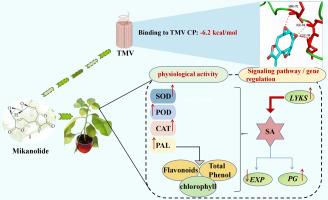Mikanolide enhances tobacco TMV resistance by strengthening cell walls via EXP/PG repression and activating defense via LYKs
IF 4
1区 农林科学
Q2 BIOCHEMISTRY & MOLECULAR BIOLOGY
引用次数: 0
Abstract
Tobacco mosaic virus (TMV) is a major pathogen of Solanaceae, threatening tobacco yield and quality. In this study, 12 compounds from Mikania micrantha were evaluated for their inhibitory effects on TMV using the half-leaf method and ID-ELISA assay. Compound 1 (Mikanolide) showed superior protective (63.43 %) and therapeutic (69.09 %) activities compared to other compounds and Ningnanmycin. It also exhibited inactivation (50.98 %) and proliferation inhibition (60.64 %) against TMV. Molecular docking revealed its binding to TMV-CP through hydrogen and hydrophobic bonds. Mechanistic analyses indicated that Mikanolide elevated chlorophyll contents, flavonoid and total phenol biosynthesis, and salicylic acid accumulation, thereby enhancing defense-related enzymatic activity. Transcriptome analyses showed increased expression of cell wall-related EXP and PG genes, as well as LYKs defense response genes, while suppressing LRR protein 66, Hsc70, BTB/POZ-TAZ, polygalacturonase, and expansins, indicating maintenance of cell wall integrity during TMV infection. RT-qPCR confirmed these results. In conclusion, Mikanolide enhances tobacco's resistance to TMV by inhibiting viral replication and proliferation and activating the plant's disease resistance signaling.

Mikanolide通过抑制EXP/PG增强细胞壁,通过LYKs激活防御,从而增强烟草TMV抗性
烟草花叶病毒(TMV)是茄科主要病原菌之一,严重威胁烟草产量和品质。采用半叶法和ID-ELISA法,对薇甘菊中12种化合物对TMV的抑制作用进行了研究。与其他化合物和宁南霉素相比,化合物1 (Mikanolide)具有较好的保护作用(63.43%)和治疗作用(69.09%)。对TMV也表现出灭活(50.98%)和抑制增殖(60.64%)的作用。分子对接发现其通过氢键和疏水键与TMV-CP结合。机理分析表明,Mikanolide提高了叶绿素含量、类黄酮和总酚的生物合成以及水杨酸的积累,从而增强了防御相关的酶活性。转录组分析显示,细胞壁相关的EXP和PG基因以及LYKs防御反应基因的表达增加,同时抑制LRR蛋白66、Hsc70、BTB/POZ-TAZ、聚半乳糖醛酸酶和扩张蛋白的表达,表明TMV感染期间细胞壁完整性得以维持。RT-qPCR证实了这些结果。综上所述,Mikanolide通过抑制病毒复制和增殖以及激活植物抗病信号来增强烟草对TMV的抗性。
本文章由计算机程序翻译,如有差异,请以英文原文为准。
求助全文
约1分钟内获得全文
求助全文
来源期刊
CiteScore
7.00
自引率
8.50%
发文量
238
审稿时长
4.2 months
期刊介绍:
Pesticide Biochemistry and Physiology publishes original scientific articles pertaining to the mode of action of plant protection agents such as insecticides, fungicides, herbicides, and similar compounds, including nonlethal pest control agents, biosynthesis of pheromones, hormones, and plant resistance agents. Manuscripts may include a biochemical, physiological, or molecular study for an understanding of comparative toxicology or selective toxicity of both target and nontarget organisms. Particular interest will be given to studies on the molecular biology of pest control, toxicology, and pesticide resistance.
Research Areas Emphasized Include the Biochemistry and Physiology of:
• Comparative toxicity
• Mode of action
• Pathophysiology
• Plant growth regulators
• Resistance
• Other effects of pesticides on both parasites and hosts.

 求助内容:
求助内容: 应助结果提醒方式:
应助结果提醒方式:


